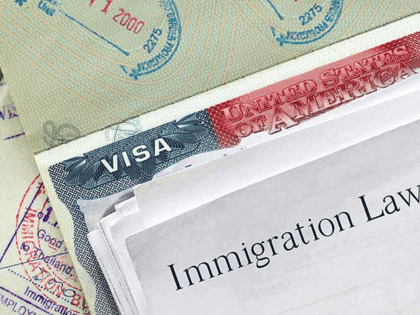L1 Visa Attorney Support
Every little thing You Need to Find Out About the L1 Visa: Advantages, Needs, and A lot more
The L1 Visa serves as an important device for multinational business looking for to move employees to the United States, assisting in both operational effectiveness and the transfer of specialized understanding. With distinctive categories for execs and specialized professionals, this visa presents many advantages, including possible paths to long-term residency. Comprehending the qualification requirements and application process is important for a successful change. As we take a look at the complexities of the L1 Visa, it becomes clear that steering its intricacies is critical for organizations aiming to utilize global ability effectively. What challenges might you encounter along the road?
Overview of the L1 Visa

Sorts Of L1 Visas

Multiple kinds of L1 visas deal with the diverse demands of international business looking to transfer staff members to the USA. Both key categories of L1 visas are L1A and L1B, each created for certain functions and obligations within an organization. L1 Visa Requirements.The L1A visa is intended for managers and execs. This category permits companies to move people who hold supervisory or executive positions, enabling them to manage operations in the united state. This visa is valid for an initial duration of as much as three years, with the possibility of extensions for a total amount of as much as 7 years. The L1A visa is specifically useful for companies seeking to establish a strong leadership existence in the U.S. market.On the various other hand, the L1B visa is assigned for staff members with specialized knowledge. This includes people that possess sophisticated know-how in particular areas, such as proprietary innovations or special procedures within the business. The L1B visa is additionally legitimate for an initial three-year duration, with extensions offered for approximately five years. This visa category is perfect for firms that call for workers with specialized abilities to boost their operations and keep an one-upmanship in the U.S.Both L1A and L1B visas enable twin intent, suggesting that visa owners can apply for long-term residency while on the visa. Comprehending the distinctions in between these two classifications is essential for organizations planning to navigate the complexities of staff member transfers to the USA successfully
Eligibility Requirements
To get an L1 visa, both the company and the employee need to meet details eligibility standards established by united state migration authorities. The L1 visa is developed for intra-company transferees, allowing international business to transfer workers to their U.S. offices.First, the company must be a certifying organization, which indicates it must have a parent company, branch, subsidiary, or affiliate that is working both in the U.S. and in the foreign nation. This relationship is important for demonstrating that the worker is being moved within the same business framework. The employer needs to additionally have actually been doing business for at the very least one year in both locations.Second, the staff member needs to have been utilized by the international firm for at least one constant year within the three years coming before the application. This work must remain in a managerial, executive, or specialized expertise capacity. For L1A visas, which deal with supervisors and execs, the worker should demonstrate that they will remain to operate in a similar capacity in the united state For L1B visas, planned for staff members with specialized expertise, the private must have distinct proficiency that adds substantially to the firm's operations.
Application Process
Steering the application process for an L1 visa entails numerous crucial steps that must be finished accurately to ensure an effective result. The initial step is to identify the suitable category of the L1 visa: L1A for supervisors and executives, or L1B for employees with specialized expertise. This difference is considerable, as it impacts the documents required.Once the classification is identified, the U.S. company have to file Type I-129, Request for a Nonimmigrant Employee. This form ought to consist of thorough information regarding the business, the employee's role, and the nature of the job to be performed in the U.S. Accompanying documents usually includes proof of the connection in between the united state and international entities, evidence of the staff member's qualifications, and details relating to the task offer.After submission, the U.S. Citizenship and Migration Services (USCIS) will assess the application. If approved, the worker will be informed, and they can then obtain the visa at an U.S. consulate or embassy in their home nation. This includes completing Type DS-160, the Online Nonimmigrant copyright, and scheduling an interview.During the interview, the candidate should provide numerous documents, consisting of the approved Type I-129, proof of work, and any type of added supporting proof. Complying with the interview, if the visa is granted, the worker will certainly obtain a visa stamp in their key, allowing them to enter the united state to benefit the funding company. Correct preparation and complete documentation are key to steering this process successfully.
Benefits of the L1 Visa
One of the remarkable advantages of the L1 visa is its capacity to facilitate the transfer of key employees from international offices to the United States. This visa is particularly valuable for multinational business looking for to keep consistency in procedures and leadership across borders. By enabling executives, managers, and specialized employees to function in the U.S., companies can guarantee that their most vital talent is available to drive company objectives.Another significant benefit of the L1 visa is its relatively straightforward application procedure compared to other work visas. Organizations can seek for the L1 visa without the demand for a labor accreditation, which simplifies the employment of international staff members. The visa can be provided for a preliminary duration of up to three years, with the opportunity of extensions, helping with long-lasting assignments.The L1 visa additionally offers a course to long-term residency. Employees on L1A visas (for supervisors and executives) can make an application for an Eco-friendly Card after one year, accelerating their modification to permanent standing. This feature is an eye-catching motivation for skilled people looking for stability in the U.S. workforce.Additionally, L1 visa owners can bring their immediate relative to the united state under L2 standing, permitting partners and children to live and examine in the country, enhancing the total appeal of this visa classification. Overall, the L1 visa works as a vital tool for worldwide businesses, cultivating cross-border cooperation and skill flexibility.
Usual Difficulties
While the L1 visa supplies many benefits for multinational firms and their employees, it visit their website is not without its challenges. One noteworthy difficulty is the strict documentation and qualification requirements imposed by the U.S. Citizenship and Migration Solutions (USCIS) Companies must give in-depth proof of the international employee's qualifications, the nature of business, and the certifying relationship in between the U.S. and foreign entities. This process can be taxing and might require legal knowledge to browse successfully.Another challenge is the possibility for examination during the petition procedure. USCIS policemans might examine the authenticity of business operations or the employee's duty within the company. This examination can result in hold-ups or perhaps denials of the copyright, which can considerably influence the business's operational plans and the employee's career trajectory.Furthermore, the L1 visa is connected to the sponsoring employer, which suggests that task modifications can complicate the visa status. If an L1 visa holder desires to switch over employers, they need to frequently go after a different visa classification, which can include intricacy to their migration journey.Lastly, keeping conformity with L1 visa regulations is important. Companies need to assure that their employee's role lines up with the initial application which business remains to satisfy the eligibility needs. Failure to do so can result in retraction of the visa, influencing both the staff member and the company. These difficulties demand complete preparation and continuous administration to guarantee an effective L1 visa experience.
Tips for Success
To effectively navigate the L1 visa procedure, careful preparation is vital. Start by completely understanding the particular requirements for the L1 visa classification you are requesting, whether L1A for supervisors and execs or L1B for workers with specialized expertise. Collect all essential documents early in the process, consisting of evidence of your employment background, organizational framework, and the nature of business operations.Engage legal advise experienced in migration regulation to direct you with the intricacies of the application. An attorney can help assure that your application is complete, exact, and engaging. They can also help in preparing for prospective demands for evidence (RFEs) by proactively addressing locations that might elevate questions.Additionally, maintain clear interaction with your employer, that should give necessary support for your application. L1 Visa. Validate that they recognize their duties, including submitting the needed requests and giving documents that validates your role in the organization.Prepare for the visa meeting by exercising responses to usual inquiries concerning your specialist history and the nature of your work. Demonstrating self-confidence and clarity can substantially influence the result of your application
Frequently Asked Questions
Can Family Members Accompany L1 Visa Owners?
Yes, member of the family can go along with L1 visa holders. Spouses and unmarried children under 21 years old are eligible for L2 visas, which enable them to live and study in the United States during the L1 holder's remain.
For How Long Can L1 Visa Owners Remain In the U.S.?
L1 visa owners can initially remain in the U.S. for up to 3 years (L1 Visa Requirements). This period may be prolonged, enabling an optimum stay of 7 years for L1A visa owners and 5 years for L1B visa holders
Is the L1 Visa a Dual Intent Visa?

Can L1 Visa Owners Obtain a Permit?
Yes, L1 visa holders can make an application for a permit - L1 Visa. The L1 visa sustains twin intent, enabling owners to go after permanent residency while keeping their non-immigrant condition, facilitating a smoother changeover to a permit
What Takes place if an L1 copyright Is Rejected?
If an L1 copyright is refuted, the applicant might obtain a notice detailing the factors for rejection. L1 Visa Requirements. They can appeal the choice, reapply, or check out different visa alternatives relying on their conditions and certifications
Verdict
In recap, the L1 Visa offers as a necessary instrument for multinational companies looking for to move workers to the United States. Recognizing the distinctions between L1A and L1B classifications, along with the qualification needs and application processes, is essential for effective navigation of this non-immigrant classification. The benefits used, consisting of structured applications and paths to permanent residency, even more enhance its charm. Addressing common difficulties effectively can result in a much more favorable result in the copyright procedure.